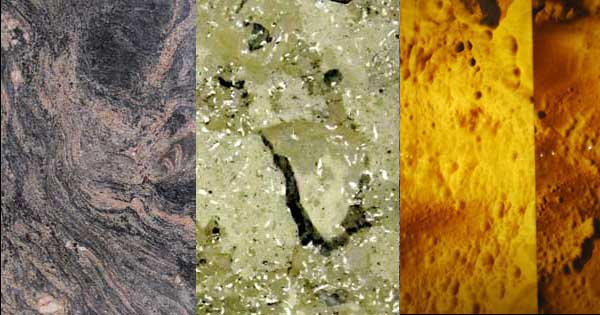
I have now seen the oldest rock I will likely ever see. I have gazed upon it. I have touched it. It is a lustrous black, swirled with pink, smooth as marble. But marble it is not. It is polished Morton Gneiss, also known as rainbow granite. It is 3.5 billion years old and it was quarried in Morton, Minnesota. I have never laid eyes on Morton, Minnesota, but I can pat this nice gneiss right here in downtown Seattle. It forms part of the Seattle Exchange Building, built in 1929 at Second Avenue and Marion Street.
I am part of a little group being led about town by David B. Williams, geologist. With his geologist shoes, geologist chinos, geologist goatee, and geologist baseball cap, Williams looks the part and he is what every city needs: an urban geologist to narrate the natural history of the stone, terra cotta, brick, and fossil marine life exhibited in plain sight everywhere. His 2009 book on the subject, Stories in Stone, tours rocks in New York, Morton, Boston, Minneapolis, Indianapolis, Los Angeles, and elsewhere.
Morton Gneiss is a metamorphic rock, metamorphic signaling changes through millions of years of Earth’s heat and pressure. The oldest rock commonly used in the building trades, it’s part of the Canadian Shield, which contains the oldest rock found in North America. Earth formed along with the solar system 4.6 billion years ago but you can’t find the solar system’s oldest rocks on Earth (except in meteorites). Plate tectonics and weathering make frequent edits to Earth’s crust.
In Seattle we ooh and aah the Morton Gneiss and then wend our way up the hill to the Rainier Club, built in 1904, remodeled in 1929. Located on Fourth Avenue, it was formerly a gentleman’s club (non-gentlemen are now admitted). I’ve passed the low limestone garden wall surrounding the landscaped grounds many times, never seeing how replete with shelly fossils it is. This is Salem Limestone from Indiana, predominately calcium carbonate. David Williams whips out his cloth bag full of magnifiers and we all peer at the fossilized remains of tiny sea creatures that lived and died in the shallow sea that was the Midwest 330 million years ago.
Next we view the travertine. Once you recognize travertine, you see it everywhere. It’s a whitish, pocked-looking sedimentary rock, a type of limestone that forms in layers, rather quickly (this wall is a mere 100,000 years old), with the help of bacteria. Hot water moves up through limestone, dissolving the calcite (calcium carbonate) along the way. Now it reaches the surface and with the change in pressure, carbon dioxide is released. The water remaining in pools becomes supersaturated with calcite, which precipitates to the bottom of the pools. Thus, travertine. (The pocks and tracks in the whitish rock are left by gas bubbles and by tiny plants long gone.) The travertine on the building labeled U.S. Bank at Fourth Avenue and University Street (for actual banking, go up to Fifth) is from Bagni di Tivoli, Italy. One of the more renowned travertine-clad buildings, Williams tells us, is the Getty Center in Los Angeles. So spectacular and engrossing are the fossils in the exterior walls of the Getty, he jokes, that there is absolutely no need to go inside.
Farther up the hill, we enter the Grand Hyatt Seattle, opened in 2001 near the Washington Convention Center on 7th Avenue and Pine Street. Oh my. The vast floors of the lobby-level corridors are made of 175-million-year-old polished limestone, sand-colored, sometimes miscalled Treuchtlingen (TROYKT-ling-in) Marble, though marble it is not. Look down. Embedded in the polished stone are dozens of fossilized cephalopods including ammonites, a squid-like creature with a circular shell. The fossils in the transcendently elegant women’s bathroom are particularly stunning. (Sorry, gentlemen.) These fossils are not small: some are big as a hand. This “Jura limestone,” according to supplier Roberto Zorzi of Antony Architectural Stone, was quarried in the upper Bavarian region of southern Germany.
And then, most awesome, a wall panel of polished honey onyx, backlit, translucent in swirls of reddish gold and ochre. Enter the hotel and turn right. It’s at the end of a long corridor. The gorgeous stone, made of calcite, was quarried in the Eskisehir region of Turkey, sent to Italy to be cut into slabs, sent from Italy to Snohomish, Washington, to Antony Architectural Stone. There it was finished, trucked to Seattle, and installed.
It is a thing of great beauty. It must be seen.

